—Choices you don’t want to regret; options you don’t want to miss

If you’ve never purchased or owned an inground swimming pool before, it’s easy to make design mistakes that may prevent you from getting what best suits your family’s needs and lifestyle.
And if you do have experience planning a gunite pool from a few years ago, you may be unaware of how designs, features, and technology have evolved.
A pool-ownership investment should yield the best possible outcome for you and your family. With this goal in mind, let’s take a look at mistakes to avoid and some innovations you don’t want to miss out on.
#1. Going too deep
Once upon a time, virtually all backyard pools were built with 8-foot deep ends. Such a dimension allowed for a “diving well” or “diving bowl” to enter the water from a springboard.
Whether or not anyone actually planned to dive in the new pool, the assumption was for the design to be deep enough for this activity.
But today, pool builders and many homeowners know that only a tiny fraction of families will use their pool for diving. Therefore, building a deep end is overkill.
Furthermore, deep ends simply don’t support the attributes that families want from their aquatic resort: comfort, ease of use, and a safe environment.
Better yet, pools without a traditional deep end provide several additional benefits for pool owners.
For these reasons, it’s a smart move to keep your pool to a maximum depth of four-and-a-half to six feet. Doing so will give you more usable space for the kind of aquatic play and lounging that nearly everyone enjoys.

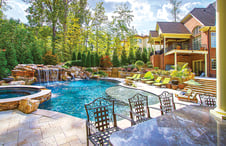
Shallow pools are more accommodating for beginning swimmers and children. These individuals are less comfortable in deep areas where they can’t stand on the bottom and still have their heads above water.
Pool interiors that are shallower are also better for water aerobics and other aquatic fitness routines. At the same time, the shorter depths don’t make the pool any less suitable for performing laps.
A common approach is to configure the pool with shallow ends on both sides, and the “deep” end in the center. These “sports pools” are ideal for activities such as volleyball and basketball, as well as a round of Marco Polo or just simple horsing around.
Yet another benefit is savings. With a smaller volume of water to heat and sanitize, you will use lower amounts of energy and chemicals.
Now, if diving is definitely on your family’s agenda, you can still have a pool with a traditional deep end.
#2. Skipping a spa
Let’s be frank: Yes, a spa will increase your project budget. So, you may be tempted to leave it off your pool plan.
But the value a spa brings is hard to quantify. This amenity will enhance the beauty of your pool and expand the ways you, friends, and family can enjoy your aquatic resort.
These small bodies of swirling hot water usually become vibrant centers for relaxing, playing, exercising, and socializing—and even for passing some romantic evenings. It’s hard to overstate what a magnet they typically become in backyard pools.
When it comes to the health benefits of hot-water immersion, multiple studies point to the benefits. Most anyone with ailments such as arthritis, back and neck pain, and muscle soreness can appreciate some heated hydrotherapy.
But even if you are free from these physical woes, you will likely take pleasure after a long day by unwinding with stress-relieving, massaging jets.
A hot soak before bedtime has also been shown to foster a better night’s sleep.
A spa is also a great spot for young children. Kids love playing on a spa’s shallow spa bench, and overall they are often more comfortable in this enclosed aquatic environment.
In some areas of the country, a spa can extend swim season. Even when it’s too nippy out for a dip in the pool, the warm bubbling spa water remain inviting.
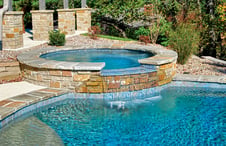

On the aesthetic front, a spa provides tremendous opportunities to create a gorgeous focal point on any pool.
Particularly by elevating the spa by at least 6 to 12 inches, this feature will add dimension to your overall poolscape.
The exterior of a raised spa serves as a ready backdrop for distinctive tile or stone. The structure’s elevation also makes it possible to fashion intriguing styles of spillways from which the spa water flows into the pool below.
If you are already planning a spa, you can raise the style quotient with another kind of spa upgrade: Introduce even more liquid drama by ask your pool builder about a jaw-dropping rim-flow spa.
#3. Forgetting shade
Shade is an essential outdoor element for comfort. But when creating a pool and backyard plan, it’s sometimes easy to overlook.
Pools are mostly used when the sun shines. Everyone loves the bright outdoors and lounging or splashing around in cool, sparkling pool water.
But everyone also wants the ability to remain outside while taking occasional breaks from direct sunlight.
Shaded areas often become key gathering places, and having shade immediately in and around your pool can make all the difference in the frequency and duration of pool use.
Including features that block those ultraviolet rays will maximize the fun in your backyard resort.
Shade can be as simple and economical as a well-placed patio umbrella in or adjacent to the pool.
By far, the favorite spot for an umbrella is on the tanning ledge.
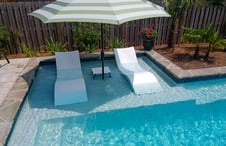

During pool construction or a major renovation, your builder can make it possible. While building the ledge, the crew can incorporate a tubular sleeve that will hold an umbrella pole.
Using a similar approach, a pole sleeve can also be integrated outside the water, along the pool or spa perimeter in the deck or coping.
Your pool plan can also call for two or three umbrellas, such as one on the tanning ledge and another along the coping to help shelter those sitting the spa or the in-pool dining table.
A more elaborate option would be a swim-up bar with a roof that overhangs the submerged barstools.
Or, if a big rock waterfall is already on your dream-pool wish list, you can go the grotto route. Along with looking sensational, a grotto-style waterfall provides some sun protection.
In this natural or faux rock formation, a large flat stone caps the waterfall. The result is a niche of varying size beneath the overhanging stone. Depending on the grotto’s position in your yard and the dimensions of the overhang, the grotto may offer a small shady respite.
Larger, more elaborate grottos have a miniature cave-like area beneath the waterfall. This secluded spot is shaded, and on a scorching day, those seeking refuge in it may find the air is often cooler to breathe
#4. Failing to extend the second step
The second step. Huh?
Let’s rewind. Over the decades, pool design has evolved. Both builders and homeowners noticed how people actually used the pool.
Today, making the pool’s interior more functional and convenient receives more attention. The emphasis happened when people were seen using the pool steps for lounging and socializing—versus simply for entering and exiting the water.
Because pool users enjoy places to relax in shallow water, new pool features were born.
One of the newest is called an extended second step.
In this pool design, the second entry step is built to wrap along the pool wall for several feet or more. At 18” deep, this elongated step creates a spacious bench.
A feature like this may seem basic and mundane. But pool owners are surprised at how much these convenient seating areas end up being used.
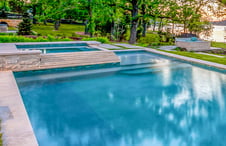
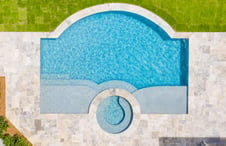
This lounge seating makes it easy to relax, and the unassuming little amenity often becomes one of the popular social hubs inside the pool.
In addition, these features are ideal for children who enjoy playing in shallow water.
Depending on your pool’s overall shape and design, entry steps can be not only functional but attractive.
One way to dress up the steps, including the specially configured second one, is with mosaics or accent or border tile.
#5. Settling for plain plaster
Pool surface options used to be limited to old-school plaster, known as marcite.
Plastered over the pool‘s concrete (gunite/shotcrete) shell to waterproof it, marcite was usually plain white or light blue.
This material creates the iconic, inviting pool image with shimmering water. But it also easily shows chips, etching, stains, and other signs of deterioration.
Some builders still offer marcite as an option, and in the short run, it carries the lowest cost.
However, if you want value with an interior surface that goes the distance and provides a more attractive appearance, you have better options.
You can upgrade your pool finish to either ColorQuartz® aggregate or to pebble. Both come in a wider color palette, distinctive styles, and varied textures.
A ColorQuartz® finish is not your father’s pool plaster. This speckled blend expands possibilities by adding fine hints of color and even reflective qualities.
Pebble finishes are prized for their superb color saturation, multidimensional texture, and handsome good looks.
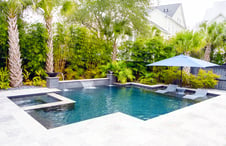
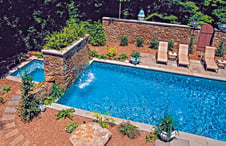
Beyond their visual appeal, both quartz and pebble material deliver significantly better durability.
Compared to a marcite pool finish, quartz and pebble stand up much better to wear from chemically treated water—particularly if it is not kept balanced.
Certain problems are typical with swimming pool plaster. But various ingredients in these upgraded finishes make them less susceptible to etching and fading from ultraviolet rays.
That means a pool interior will maintain its looks over time without a new coat of plaster as frequently (assuming pool chemistry is continuously well-maintained).
Various blemishes are less-visible on a quartz pool interior, and quartz is easier to clean than marcite. It also beats out marcite on long-term performance.
A high-end pebble finish is even tougher, will steadfastly hold its color, and will typically endure 20 years.
Compared to plain marcite, color quartz and pebble will require a bigger budget. But these options make up for it over time by delivering better looks, performance, and durability.
#6. Skimping on lighting
Back in the day, most backyard pools had a single white light in the deep end. Some say the bulb’s glare had all the charm of an oncoming locomotive.
You can have the same technology as what was in your parent’s swimming pool. But aside from a small initial saving, why would you?
With the advent of fiber-optic lighting, and then LED technology in the Nineties, illuminating a swimming pool entered a whole new, dazzling era.
Light-emitting diodes or LEDs are made for swimming pools and deliver results that are gorgeous, multicolored, and high-performing.
First of all, LED systems turn pools into jaw-dropping night-time attractions.
Bathing your pool & spa in blues, whites, greens, golds, and pinks, LEDs create a radiant aquatic vision in your backyard when the sun goes down.
With the available control systems, you can easily set the LED system to remain static on your favorite jewel-tone choice, or, you can direct the system to continuously cycle through the spectrum.
You can also synchronize the colors in the pool & spa, or set them in contrasting choices.
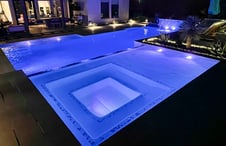

But to really amp up the evening entertainment, you want the ability to put on spectacular “light shows”. Better pool LED systems produce these dynamic, pre-programmed performances.
In these mesmerizing programs, dozens or even hundreds of colors flash in pre-set sequences at various speeds, depending on the theme.
For example, a “tranquility” theme cycles slowly through a collection of vivid blues and whites, whereas the party playlist for “Mardi Gras” generates rapidly dancing green, gold, and purple.
Along with LED’s special ability to catch everyone’s attention, they capture energy savings. This ultra-efficient technology uses far less power than conventional light bulbs.
LEDs also provide better performance. Since the diodes last for thousands of hours before burning out, you can expect years of performance.
#7. Under-sizing your deck
When it comes to pool decks, often size does matter.
Many pool owners regret not devoting enough backyard space to hardscape. Don’t be among them.
It’s important to realize that what goes on around the water is just as important—and as much fun and relaxing—as what you do in the water.
Beyond the water’s edge, a properly sized deck can be crucial for maximum backyard enjoyment.
The goal is a deck that makes your pool and backyard more attractive, versatile, and functional. Along with decking material and configuration, the total square footage warrants careful consideration and budgeting.
Most average-sized pools in the U.S. have at least 300 square feet of deck. But this is really the minimum to allow for a few feet of deck to surround three-fourths of to all of a pool’s perimeter.
At the very least, almost everyone should have enough deck to place a couple of lounge chairs and a side table or two. But that is only the bare starting point.
Do you have a family of four or five who will frequently use the pool and patio? Plan to have friends over for backyard pool parties? Will your children’s pals often be joining them for swims?
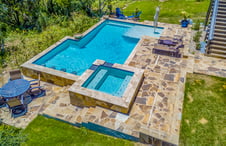
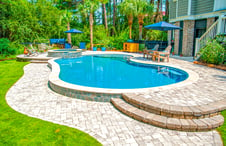
If so, you will probably want more than just a couple of chairs and side tables, and that takes deck space.
In addition, might you want to occasionally eat al fresco? If yes, you might need to space plan that also accommodates a dining table and chairs.
Plans for grilling? Outdoor meal prep and service? Your deck will need a spot for a BBQ or maybe even an outdoor kitchen.
What about a fire pit? Will there be stairs or a path from the deck that leads up or down to your house? Either requires devoting some deck space.
A good rule of thumb is to have at least the same square footage of deck as the square footage in a pool.
For example, a 15 x 30-foot pool is 450 square feet. So at a minimum, 450 square feet of decking is usually advisable.
Investing in a deck that enables comfortable flow around the pool, accommodates features for relaxation and recreation, and socializing with family and friends




.jpg?width=1490&name=rock-waterfall-slide-pool%20(1).jpg)